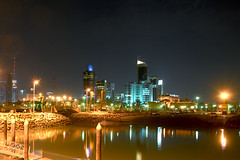Our cameras (whether digital or film-based) are limited by the amount of dynamic range that they can capture. In photography, dynamic range refers to the difference between the darkest and the brightest area in the picture frame. So if you are trying take a picture where some part of the picture is extremely bright while other parts are in shadows, your camera will struggle to get a decent exposure of the scene. That's why pictures taken on a cloudy day look so great. The dynamic range is low enough for the camera to capture everything within the frame perfectly.
Films are generally better at capturing dynamic range while the tiny sensors on digital point&shoot cameras or cell phones are the worst offendors. Digital camera manufacturers use different techniques to overcome the limitations of their imaging sensors. The current champ in dynamic range capture is the Fuji FinePix S5 Pro which uses 2 separate imagers (one for highlights & one for shadows), and then combines them during post-processing to give you an image with a much better dynamic range.
A software based alternative for maximizing dynamic range is to take multiple exposures of the same scene at different EV values and then combine them to generate a single image. Obviously, this will only work for static objects such as archtechture or landscape.
Last year, HDRsoft created a lot of buzz when they introduced a software called Photomatix that merged multiple images using an unique algorithm called "Tone-mapping". I got involved in the buzz and went ballistic with the software, creating some freaky tone mapped images.
But the problem with "tone-mapped" images is that they look too artificial. Photoshop CS2 has a more subtle technique for merging multiple exposures. In this example, I used the Photoshop menu option "Merge to HDR" to combine 7 different exposures taken at +/- 1EV apart. This essentially created a 32-bit HDR image. The image was then converted to 8-bit using the "Exposure & Gamma" option, which essentially tries to balance the contents of all the 7 images to give a well-balanced photo.
And the best part is that it does not look artificial like tonemapped HDR. A normal person looking at this example photo will merely thing it is a nicely exposed image.

1 comment:
you seem to know a lot about cameras :) HELP ME!
I want to buy the nikon d40x, I want to buy it just to kick start the learning process.. I know almost nothing about cameras.. all I know is how to take good pictures in the point and shoot cameras.. but I just want to move on and get to know real cameras and take some amazing pictures.. you know.. a hobby in the making..
so what do you think? is it a good camera? is it too complicated? should I read about cameras more first before I go ahead and buy one?
Post a Comment